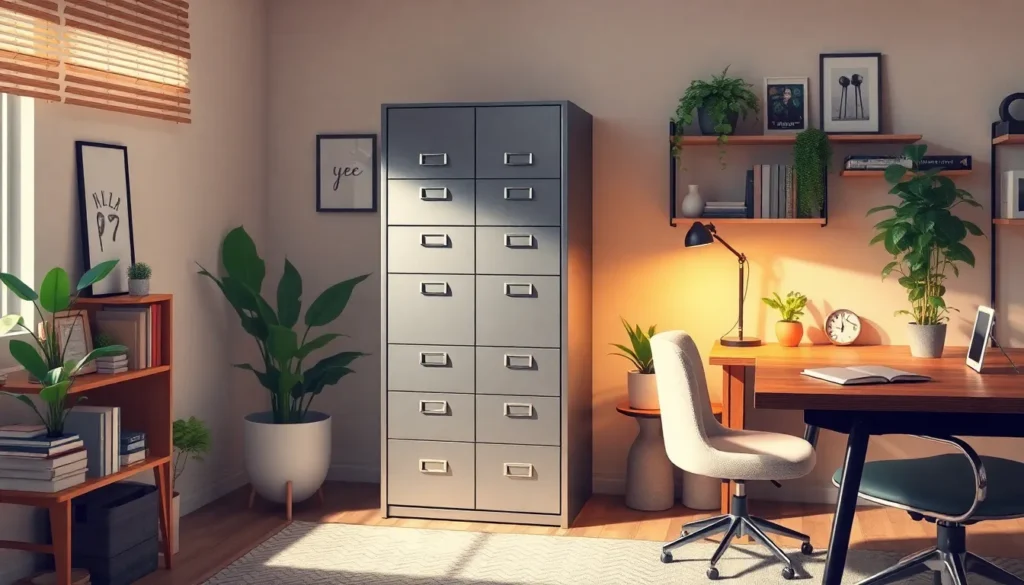Table of Contents
ToggleIn the world of remote work, a home office can either be a productivity powerhouse or a chaotic mess. Enter the unsung hero of organization: the filing cabinet. This sturdy piece of furniture not only keeps papers from staging a coup on your desk but also adds a touch of professionalism to your workspace. Who knew that a metal box could be the difference between a zen-like work environment and a paper avalanche?
Importance Of Home Office Filing Cabinets
Home office filing cabinets play a vital role in enhancing organization and efficiency. They significantly contribute to a streamlined work environment.
Organization Benefits
A well-organized filing cabinet simplifies document management. Files become easily accessible, decreasing the time spent searching for important documents. In addition, categorized storage systems foster better organization, making it simpler to locate records. A filing cabinet reduces clutter, creating a more organized workspace. This leads to improved focus and increased productivity, ultimately elevating work performance.
Space Efficiency
Filing cabinets optimize the use of available space. They provide a dedicated area for documents, eliminating the need for scattered papers across desks. Vertical designs maximize floor space while offering ample storage capacity. Employing rolling cabinets allows for easy movement and reconfiguration as needed. Choosing cabinets with multiple drawers accommodates various document sizes, ensuring a more efficient setup. Overall, filing cabinets enhance functionality within a compact home office environment.
Types Of Home Office Filing Cabinets

Home office filing cabinets come in various styles, each designed to meet specific storage needs. Understanding the different types can aid in selecting the best option for a productive workspace.
Vertical Cabinets
Vertical cabinets typically feature a slim design, conserving floor space. They often include multiple drawers, making it easy to categorize and store files. Users appreciate the ability to maximize vertical storage, which suits smaller home office setups. Many vertical cabinets can accommodate both letter and legal-sized documents, enhancing adaptability. The focused design of these cabinets improves accessibility to essential files, reducing time spent searching.
Lateral Cabinets
Lateral cabinets provide a broader storage surface while maintaining a low profile. They contain wide drawers that can hold a large volume of documents, making them suitable for extensive filing systems. Users often favor lateral cabinets for their ability to double as extra workspace for printers or decorative items. The drawers generally glide smoothly, enhancing functionality with ease of use. Their design allows files to be accessed from the front, streamlining retrieval during busy work hours.
Mobile Cabinets
Mobile cabinets offer versatility through wheels, enabling easy relocation within the workspace. These cabinets often serve as both filing solutions and mobile workstations, providing convenience. Users find it helpful to keep important documents close at hand while working from different areas. Many models come with locking mechanisms, ensuring document security when needed. Compact dimensions ensure these cabinets fit neatly under desks, optimizing space without sacrificing functionality.
Features To Consider
When selecting a home office filing cabinet, several key features play a significant role in usability and functionality. These features enhance both organization and productivity.
Size And Capacity
Size and capacity impact how much storage space a filing cabinet provides. Assessing the available space in the home office is crucial before making a selection. Vertical cabinets typically take up less floor space while offering multiple drawers for a high storage volume. Lateral cabinets provide broader drawers, accommodating larger files and additional items. Mobile cabinets, while compact, also serve various storage needs with flexible capacity. Understanding personal document storage requirements facilitates choosing a cabinet that meets specific needs within the workspace.
Locking Mechanisms
Locking mechanisms ensure the security of important documents in a home office. Some cabinets come equipped with built-in locks, providing peace of mind for sensitive information. A secure lock system deters unauthorized access, which is particularly important for home offices that may face visitors or shared use. Different types of locking mechanisms, such as key locks or combination locks, exist, letting users choose based on their security preferences. Assessing the type of documents stored enables informed decisions about the necessary locking features.
Material And Durability
Material and durability define the longevity of a filing cabinet. Common materials include steel, wood, and composite options, each offering distinct benefits. Steel cabinets deliver high durability and can withstand heavy use, while wooden cabinets provide aesthetic appeal and warmth. Composite materials may offer lightweight and budget-friendly options without sacrificing appearance. Evaluating how frequently the cabinet will be accessed and the type of documents it will hold aids in selecting a cabinet that meets both durability needs and stylistic preferences.
Tips For Organizing Your Filing Cabinet
Organizing a filing cabinet enhances efficiency and accessibility. Implementing effective strategies ensures a streamlined document management system.
Categorizing Documents
Categorize documents based on type and frequency of use. Financial records, project files, and personal documents can each have distinct sections. Using a numerical or alphabetical system aids in quick retrieval of files. Grouping similar items together minimizes time spent searching and boosts productivity. Important papers should get prioritized placement for easy access. Regular audits help to keep categories relevant and streamlined over time.
Labeling Techniques
Labeling significantly improves filing systems. Clear, concise labels make it easy for anyone to find necessary documents without confusion. Color-coding can enhance visibility and organization, as different colors signify file types or priorities. Utilize standardized label sizes and fonts for consistency across the cabinet. Consider using removable labels for flexibility in changing categories or contents. Regularly update labels as documents evolve, maintaining an organized and professional appearance.
Investing in a home office filing cabinet can transform a chaotic workspace into an organized haven. By providing dedicated storage solutions, these cabinets enhance productivity and streamline document management. With various styles available, individuals can choose options that best fit their space and needs.
Proper organization within the filing cabinet not only saves time but also fosters a more focused work environment. Regular maintenance and thoughtful categorization ensure that important documents are always at hand. Ultimately, a well-chosen filing cabinet is a valuable asset that contributes to a more efficient and enjoyable home office experience.







